Retro spotlight: Phantasy Star III: Generations of Doom
The black sheep of the original Phantasy Star games is loaded with ambition and skill, but it's the odd one out for a reason, too.
This column is “Retro spotlight,” which exists mostly so I can write about whatever game I feel like even if it doesn’t fit into one of the other topics you find in this newsletter. Previous entries in this series can be found through this link.
Phantasy Star III: Generations of Doom is kind of a funny game. The original Phantasy Star was an obviously ambitious blend of Dragon Quest-style battles and first-person dungeon crawling, featuring a woman as the protagonist, that helped influence a generation of games. Its sequel, Phantasy Star II, kept the dungeon crawling but made it all topdown, while cranking up the everything: had it released with a little more polish or later during the golden age of 16-bit RPGs, you’d have more people claiming it as an all-timer than already do. (Alas, Sega had deadlines, and they were strict.) And Phantasy Star IV is, for many, the best of the bunch, thanks to its emphasis on additional story that’s both engaging for its content and how it presents itself, and a pacing that is practically unmatched in the genre.
What’s the legacy of Phantasy Star III? That depends on how charitable you are in your approach to it. It’s either yet another ambitious Phantasy Star game that suffered even more than the others from the technology of the day and Sega’s general impatience with development time, as it features all kinds of cut content — much of it narrative — in order to squeeze that very ambition onto the cartridges of the day on the schedule the team was given. Or, it’s a game that feels out of place with the other three mainline ones, both in quality and in its whole vibe, to the point where it’s a wonder that Sega didn’t just release it as a spin-off “gaiden” rather than making it the third entry, if they were that desperate to have another so soon after the first two released.
The truth is probably somewhere in the middle. Phantasy Star III is often derided for what it isn’t and what’s missing from it, but what’s there is awfully compelling, even over three decades later. That’s not to say what’s there is without flaws, or that time has helped every aspect of the game, because it is both full of flaws and, in some ways, felt a little old even when it released overseas in 1991, thanks to the makeover Square gave Final Fantasy in time for its 16-bit debut. Is Generations of Doom a great game? I wouldn’t go that far, no, it’s very clearly a tier or two below the other mainline titles. But there’s still enough here for you to play it at least once, to get a sense of what Phantasy Star III is instead of what it isn’t, and what it is manages to still be intriguing even with its obvious flaws.

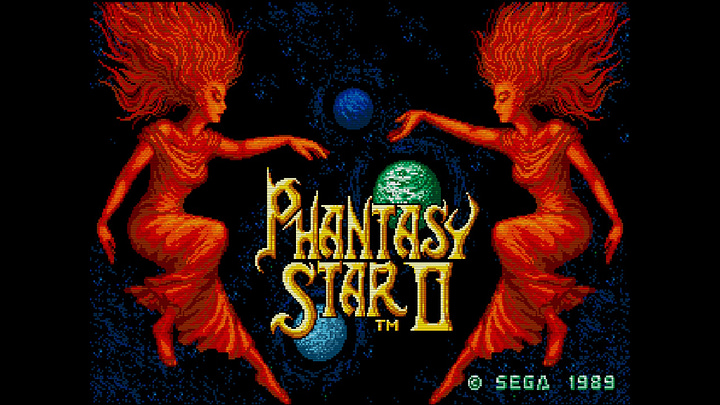
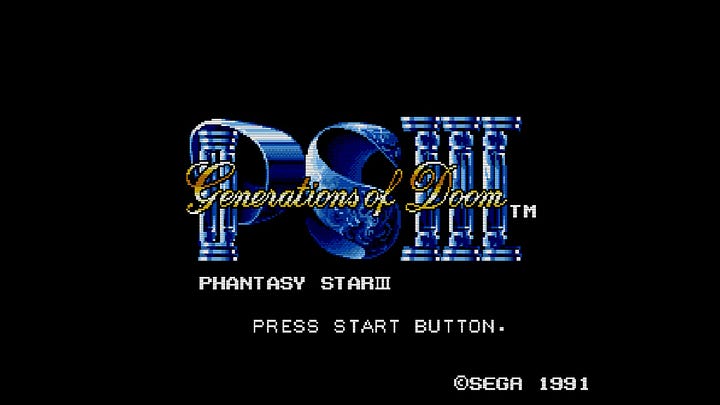
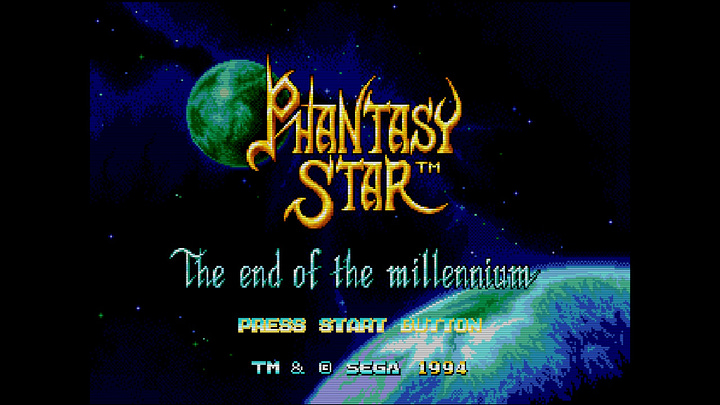
Right out of the gate, Phantasy Star III presents itself as different from the other Phantasy Star titles. Before you even begin the game, you can see that this is true, simply by looking at the title screen and recalling what the previous two looked like. Phantasy Star IV, understandably, returned to the previous visual aesthetic that involved the stylized yellow font and an understanding that the “star” in the title meant yes, space played a significant role in this game. Hiding that a little bit on the title screen in III makes a certain kind of sense, because the characters in the game don’t know they are — spoiler — flying through space in a ship and believe themselves to instead be on a planet with a lot of maintenance tunnels connecting the different areas of it, but that’s kind of Phantasy Star III’s whole thing. If you squint long enough, then the decisions they made can make sense, but it probably would have been easier to not create a situation where the player has to constantly stop, think, and sigh out an, “I guess.”
Phantasy Star III does not shy from the sci-fi elements — the first party member you recruit is a cyborg — but it attempts a balancing act with the player and the game’s characters that doesn’t always pan out. You, as a player, likely know about Phantasy Star’s history, and that the first two games took place in the same star system, on the same planets, with the second game even featuring a catastrophic blow to that system owing to the destruction of the planet Palm. The characters don’t know anything about this. There are cyborgs, sure, and some remnants of tech scattered about such as hangars you can’t use until you’re near the end of the game, dungeons that connect one region of the game to another that are very obviously made out of what we’d consider a sci-fi design, but the game is more fantasy than sci-fi in its presentation. You’re a prince set to marry a mysterious woman your kingdom saved, and then she’s kidnapped by a dragon; your father, the king, then sends you to the dungeon instead of having you attempt to reignite war with a country that’s supposedly not been seen for 1,000 years. You don’t get much more fantasy based than that for a setup.
Meanwhile, Phantasy Star opens with an homage to Star Wars’ stormtroopers murdering Alis’ brother in a clearly futuristic city. Phantasy Star II begins with you in a world that features a cloning station and teleportation center. Security checkpoints requiring ID cards, spaceports, climate-controlled everything; this isn’t a fantasy setting, at least, not primarily. And while Phantasy Star IV arrived after III because that’s how sequential numbering works, it opens with bounty hunters going to a university that has a basement full of monsters who all turn out to be genetic experiments: Phantasy Star IV manages to be a world without much access to the futuristic technology of the past titles, at least at first, that still clearly and loudly presents itself as taking place in a world where that kind of technology used to exist, a world where people now try to reclaim some of what used to be the standard. Phantasy Star III’s citizenry seems to have no clue about their past, and have gone backward from a technological point of view without any clear explanation as to why like exists in Phantasy Star IV. Which is even more confusing when you consider that these people live on a spaceship so advanced that they believed they were actually on a planet this whole time.
Maybe the relationship between Phantasy Star’s past and the story of III was much clearer in the version of the game we didn’t end up with, the one with the cut content. According to the 1993 Japan-only book, World of Phantasy Star: The People Who Made Phantasy Star, significant cuts had to be made to narrative content in order to realize the admittedly impressive scale of the world that the game’s multi-generation tale would be told within — maybe if Sega hadn’t pushed development to wrap as aggressively as they did, another solution would have been found that kept Phantasy Star III from feeling so out of place with little explanation, but we don’t know for sure. And since there was no Generation remake of Phantasy Star III, either — these Playstation 2 releases expanded and updated the first two games in Japan, as part of the Sega Ages 2500 series, with much of that expansion on the narrative side now that there was room to do so — we aren’t going to, either.
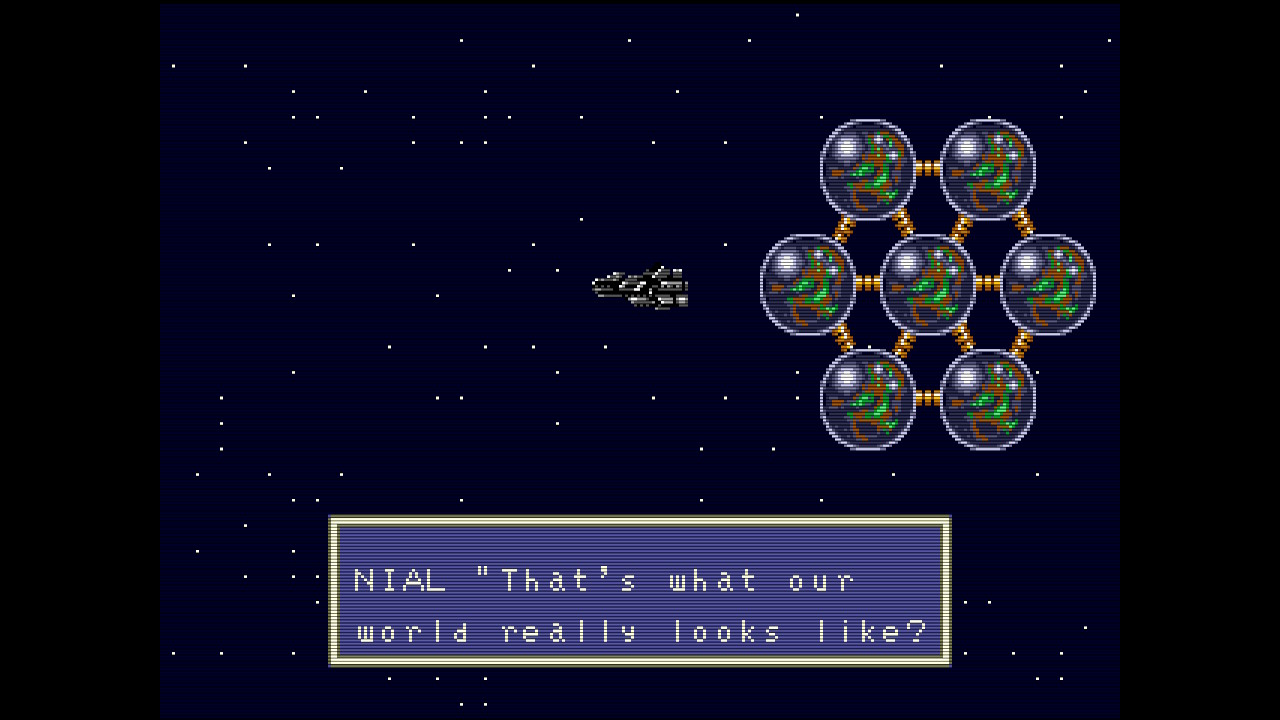
I should make it clear that I believe the idea of a reveal itself showing life is different than expected for the characters isn’t a negative. Phantasy Star III just sort of awkwardly stumbles into it, however, due to the general lack of world-building that occurs in-game. NPCs in towns don’t have much to add to the world other than maybe telling you where to go. Conversations occur at story points, but are pretty focused and often leave you a little more confused than enlightened, as well. There’s little to actually explore in-world outside of the places you’re supposed to be: Phantasy Star III is a game with a lot of empty houses in it, full of beds no one sleeps in. So it’s no wonder that eventually, someone just goes, “hey why don’t you try getting on this spaceship and then go to space in it?” and none of your characters even so much as go, “space…ship?” or “oh cool I didn’t know there was a spaceship here” to let you know whether this is meant to be a reveal or a fact of life so mundane it explains why no one has bothered mentioning anything like it over the previous dozen hours.
Nearly everything just feels a little off like this. The art features far more muted colors than in the bright and colorful Phantasy Star II, and so even though the graphics themselves have improved from a technical standpoint, this change in design makes them look much flatter and comparatively boring. The large-size character sprites have once again been removed from battles — there are now actual backgrounds because they dedicated space to that unlike in PSII, but still, it’s hard not to assume that this choice was made because there were just so many party members possible in the game, and nowhere to store all of their sprites. Similarly, on the narrative side, the number of large-scale cutscene pieces is way down, and just a few characters in the game even have character portraits when they speak, which is also relatively rare.
There’s nothing wrong with the enemy designs, but they don’t necessarily vibe with the kinds found in the two preceding games. The inspiration for many enemy types seems to be “abstract” or “horny,” but never abstract and horny. Pretty much any human or with-human-qualities enemy you face will be a woman showing off a bunch of skin or wearing the tightest possible garb or both, but you will also face off against giant floating rock heads and possibly pieces of sentient walls and floors as well as phase-shifting… somethings? It’s tough to know. It all looks sick, though, in a way so much of the other art in the game does not.
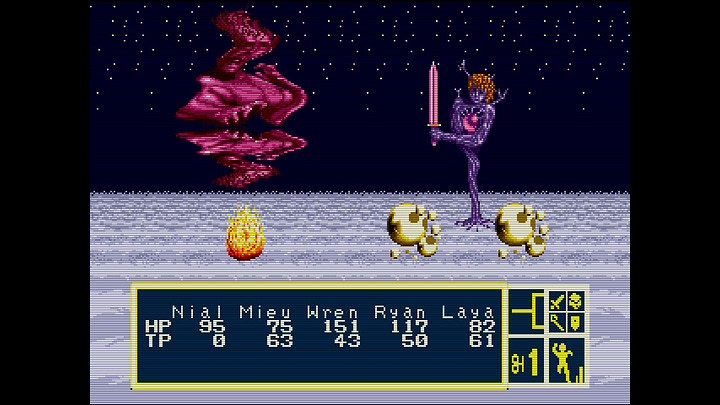
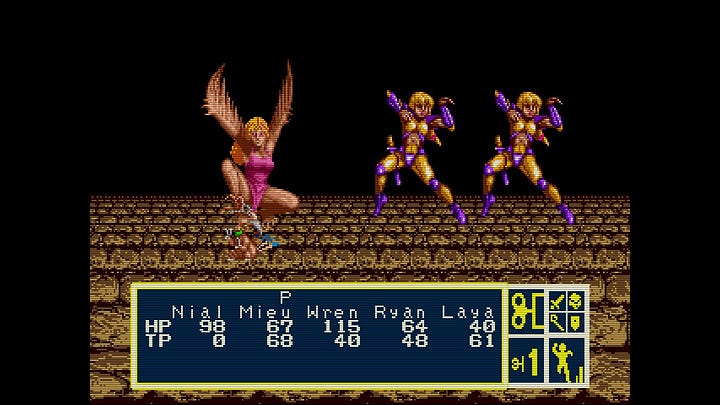
You’re probably noticing a theme here, but that’s because I do fall on the side of thinking that maybe Phantasy Star III should have been a spin-off instead of a mainline game. Sega maybe even retroactively believed as much: the planned international Sega Ages release of the Generation games would have been a bundle that included Generation 1, 2, and… 4. In truth, though, Phantasy Star III isn’t any different than the game-to-game changes that Final Fantasy went and still goes through. The difference here is more that Final Fantasy was designed that way from the first sequel, whereas Phantasy Star III’s flirtation with being outside of the expected but also part of the known puts it in a more precarious position, reception-wise, speaking both about the moment it released and now, 30-plus years later.
What Phantasy Star III did do very well was in its more structural changes that altered how you would play but still kept it all very Phantasy Star. Like with Phantasy Star II ditching the first-person dungeon crawling but managing to create topdown labyrinths that were just as deviously complicated and challenging, Phantasy Star III brought its own twist. The “Generations” part of the title isn’t just for show: Phantasy Star III takes place over three separate generations, to conclude a story that began 1,000 years prior. You’ll begin the game as Rhys, the crown prince of Landen, who was set to be married before that whole incident with the fiance-snatching dragon. Rhys will escape the dungeon with the help of a mysterious woman, and then form a party with cyborgs, said mysterious lady, and her brother, who just happens to be a powerful mage who, by the way, can shape-shift into a dragon. Oh, and he hails from the same homeland as the captured bride-to-be, who, it turns out, was being rescued from the point of view of that dragon, as the Layans believed that the Orakians — the nationality of Rhys — had kidnapped her from them. It’s all a big misunderstanding on a number of levels, since the Orakians simply found her and nursed her back to health before their crown prince got thoughts of marriage in his head, and oh, also, it turns out that all the conflict of the previous 1,000 years, including this one, was engineered by a malevolent agent of darkness who feeds on the agony and suffering of humanity.
You learn more about that last part later on — hours later in real life, but decades in-game — but before then, you’ve got some dungeons to get through, as well as some choices and babies to make. The dungeons are wildly simplified from the previous Phantasy Star games, to the point of it being something of a detriment, but there are two likely reasons for this decision. The first is that there’s quite a bit of backtracking and returning to where you have previously been in this game, owing to its generational gameplay. The second is that there probably wasn’t cartridge space to make much longer and more complicated dungeons: the game relies on a high encounter rate and more powerful enemies indoors than outdoors to keep the dungeons challenging. And hey, it works, it’s just, like with many things, not as good as what came before or after.
As for the choices and babies, those two things are related. Rhys will end up reaching Maia, his almost-wife, in her homeland. He’ll fight for the right to be there and have a shot at marrying her if he succeeds, but then, a twist: it turns out the mystery woman from before, Lena, also has a thing for Rhys. Marry Lena and become king of two united kingdoms, or marry Maia as you had initially intended, only doing so in Layan territory instead of Orakian? There are a few ways to go about making your choice, and I’ve got to tell you, none of them have anything to do with character personalities or dialogue or scenes you’ve experienced, because none of this exists in Phantasy Star III. So instead, you can go by “which character am I used to having around” or “what hair color do I want my kids to have” or “do I want my kid to be able to use Techniques or no” and end up satisfied with the result of your decision.
In the case of Rhys, you set out to rescue Maia, but trekking through her homeland made quite a few people take a moment out of their day to tell you that you’re a huge piece of shit they’d kill if there weren’t laws against that sort of thing — this is not an exaggeration — so maybe just retreating to marry Lena is going to sound appealing. Or maybe you think, hey, tensions are kind of high, but the Layan people will accept me if they just get to know me. Or, “I don’t know, both Rhys and Maia have blue hair so I feel like he’s marrying his sister here” so you choose Lena instead. You’re going to have to do the rationalizing yourself, but you’ll have to make a decision between the two regardless.
Married Lena? You have a son, Nial, with brown hair and no ability to use Techniques, and you’ll control him after an 18-year time jump, back in the territory his father grew up in. Married Maia? Ayn’s your blue-haired man — well, boy, since his story picks up 15 years later — who can use Techniques due to his Layan mother, and will do so starting from mom’s homeland. Nial will face off against a terrifying opponent, a very angry and powerful man from 1,000 years in the past who has been in cryogenic sleep and unhappy about it the whole time, one who summons all kinds of monsters to the world to aid him in his revenge. Ayn has to deal with a cyborg uprising instead: the monsters clear out of the world here, replaced by all kinds of robots and more sci-fi-oriented opponents. You’ll find many of the same key items on these differing quests, but where you go and who you see and who you partner with will be different depending on your protagonist.
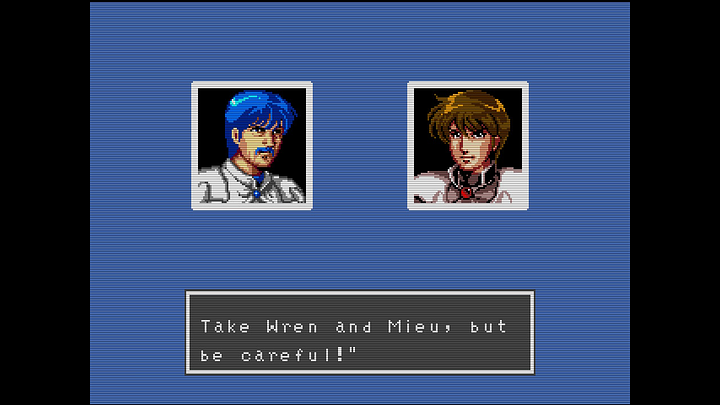
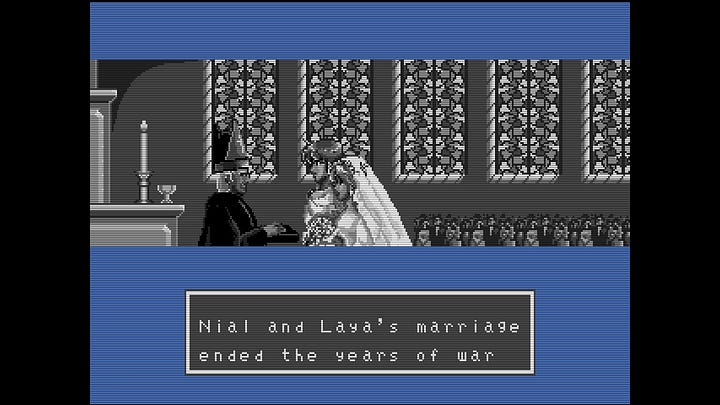
Nial gets the option of marrying two different women, as well, as does Ayn, which results in four other possible protagonists to play as for Phantasy Star III’s final act. The first section of those final acts is different, but the rest of them are the same, given that the game needs to come to its resolution that involves, regardless of who is doing it, in defeating Dark Force. Who is on this station, by the way, because the ship is one of the colony ships that escaped the destruction of the planet Palm in Phantasy Star II, and just so happened to have an incarnation of Dark Force along for the ride.
Each of the protagonists play differently, given they tend to get quite a few traits from their mother, and in the final act, you even get cousins or siblings who resemble either mom or dad or a key figure from the previous arc, as well. Your cyborg party members, Mieu and Wren, persist throughout the entire game, so you always have a couple of well-equipped and strong party members to back you up when you’re back at level 1 again and facing off against more powerful monsters and robots than your dad ever did.
All of this is really cool, and the fact that Phantasy Star III has a main quest that splinters off into two differing second acts and four third acts that, at least, begin in different places, remains impressive. That this was first released in 1990 is pretty mind blowing, and certainly shows that, even though Phantasy Star III was designed by a completely different team than the first two games, they at least understood the spirit of the series and the ambition its games were known for. That all being said, none of the Phantasy Star games needed a Sega Ages update with additional narrative and world-building than Generations of Doom, and part of the evidence that Sega was aware of that fact comes in the form of Phantasy Star IV, which scaled back the overall scope of the world in order to tell — and tell well — a more focused and successful story. Phantasy Star III succeeds, too, but it does so mostly due to its relative uniqueness and undeniably lofty aspirations, which still leaves you feeling as if things could have been different and better.
Still… those aspirations just shine through. Battles feature dynamic music, which changes depending on things like whether you’re attacking or being attacked, picking your what you’d like to do by setting macros, or on how well the fight itself is going. The overworld music adds layers as you add party members. This was Izuho Numata’s first attempt at composing a game as the lead, and while she says she has regrets owing in part to the condensed development schedule, what she managed to produce in a month’s time is astounding: while the usual Phantasy Star team returned for IV, Numata was once again composing for that one for a reason, and that turned out even better.
Phantasy Star III is a good RPG with much better ideas than its team was capable of fully seeing through. Given a proper development schedule that didn’t have Sega rushing to capitalize on Phantasy Star II — itself rushed out before it was fully finished cooking — it would likely be remembered much more fondly. Weird, still, given how the two previous Phantasy Star titles went, but less suspiciously, negatively weird, and more the kind of odd game that’s still worth it. As is, Phantasy Star III has plenty to offer if you’ve got the patience for this kind of old-school RPG with high encounter rates and loads of backtracking that doesn’t feature very much assistance for the player at all — and you can currently do so through the Sega Genesis Classics collection released on modern platforms. It’s just that III has less to offer than the rest of the Phantasy Star games, and, due to it being narratively out of step with them, as well, can also be skipped if you’re just looking to understand what went down in the Algo solar system over the course of the adventures of the people actually living there.
This newsletter is free for anyone to read, but if you’d like to support my ability to continue writing, you can become a Patreon supporter, or donate to my Ko-fi to fund future game coverage at Retro XP.




Great article. I agree with most of your points.
PSIII looks and feels like dollar-store Phantasy Star in a lot of ways, but like you said, I appreciate its ambition and I don't feel like I have to grind my life away in order to get anywhere. That was my problem with Phantasy Star II. I'd grind for hours just to get my characters leveled up to walk a few steps, then it'd be back to grinding. Never again.
I remember playing Phantasy Star III after my cousin got it for Christmas in 1991, at the same time I got Final Fantasy IV (then-styled as "II"). The generational concept was neat and there was much less required grinding than Phantasy Star II - though you could grind a ton if you were inclined to be a completionist. I remember being towards the start of either the second or third generation and coming across a store with a couple of incredible weapons that cost a huge amount of meseta. And the music was awesome! But other than music and the large character sprites, it really suffered in comparison to Final Fantasy IV. I'm not sure I could put in the time to play Phantasy Star III through to the end now but I think about it every so often.